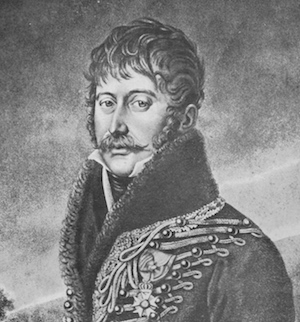General Adélaïde Blaise François Le Lièvre de La Grange et de Fourilles

Born: December 21, 1766
Place of Birth: Paris, Paris, France
Died: July 2, 1833
Place of Death: Paris, France
Arc de Triomphe: DELAGRANGE, A. on the east pillar
Pronunciation:
The oldest son of General François Joseph Le Lièvre de la Grange, Adélaïde Blaise François Le Lièvre de la Grange joined the regiment of Artois in 1781. The next year he was commissioned as a sous-lieutenant and then in November of 1789 after the start of the French Revolution he was promoted to capitaine in the Queen's Dragoons. In March of 1792 La Grange became an aide-de-camp to Marshal Luckner and then three months later he was named a lieutenant colonel in the 6th Dragoons. That September he was again promoted, this time to colonel of the 15th Dragoons, and then he served at the Battle of Valmy where he was wounded by a shot to the arm. The next month La Grange took command of the 5th Hussars which he commanded for the next year with the Army of the North. In October of 1793 he was suspended in his functions for being a noble, and then he was arrested and detained at Arras. Three months later in December he was released. La Grange remained without a command for a number of years, but he was in Paris in October of 1795 and he took part in the events of 13th Vendémiaire where General Bonaparte fired a "whiff of grapeshot" to disperse the royalist mob.
In May of 1800 La Grange was finally given a new command, serving with the 24th Chasseurs à Cheval. He went on to serve with the Army of Italy and he took command of the 7th Chasseurs à Cheval in 1801. In 1803 La Grange served for a period of time in Holland before joining the Army of the Coasts of the Ocean. In 1805 As the Grande Armée marched east to confront the Third Coalition, La Grange served with the 2nd Division of Marshal Augereau's VII Corps. In September of 1806 he joined Durosnel's division for the campaign against Prussia and then in June of 1807 he fought at the Battle of Heilsberg where he was wounded by a shot to the thigh. Later that month La Grange was promoted to général de brigade.
1808 saw La Grange serving in the Spanish Peninsula as commander of the 1st Cavalry Brigade serving under General Gobert. In this command he took part in the Battle of Bailen where French forces under General Dupont surrendered to the Spanish. La Grange protested against Dupont on the decision to surrender, but to no avail. As one of the senior officers taken prisoner, La Grange was transported by sea to Marseille where he arrived in November. When Austria attacked in April of 1809, La Grange was given command of a brigade in Lasalle's division in the Army of Germany. The next month he fought at the Battle of Aspern-Essling where he had one of his arms taken off by a ball. The next month he was promoted to général de division and then in August he took command of the province of Upper Austria.
In 1811 La Grange was named a Baron of the Empire and he was given command of Antwerp. For the Russian campaign of 1812, he commanded a division of Marshal Augereau's XI Corps that was left in reserve in Germany while the Grande Armée marched deep into Russia. At the end of the year La Grange took command of a division of infantry at Stettin. In October of 1813 he was named governor of Wesel and in February of 1814 he was ordered to command the levée en masse of the department of Seine-et-Marne.
After Napoleon's abdication and the Bourbon Restoration, La Grange was named captain lieutenant of the 2nd Company of Musketeers. When Napoleon escaped from exile in 1815 to return to Paris, La Grange followed the king in departing France but he stopped at Béthune. That July as he was returning to Paris, royalist soldiers insulted and struck him at Arnouville for not following the king all the way to Ghent.
Bibliography
Related Pages:
Updated May 2019
© Nathan D. Jensen